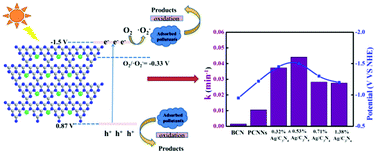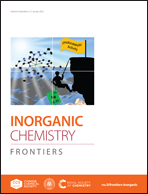Controlling the band structure and photocatalytic performance of single atom Ag/C3N4 catalysts by variation of silver concentration†
Abstract
Single-atom dispersed carbon nitride photocatalysts have been extensively associated with clean energy conversion, storage and utilization. However, it is still a challenge to elucidate the relationship between the electronic structure of catalysts and their photocatalytic properties. In this work, single atom Ag/C3N4 catalysts have been prepared via pyrolyzing cyanuric acid, AgNO3 and melamine as precursors. We observe that their photocatalytic activity increases on increasing the concentration of Ag from 0.32% to 0.53%, and subsequently decreases on further increasing the concentration of Ag, which indicates that the concentration of Ag atoms can control the performance of single-atom catalysts. Deep investigations suggest that the concentration of Ag atoms can modulate the bottom of the conduction band (CB) and the maximum of the valence band (VB). The higher the bottom of the CB is, the better the performance of catalysts is. In contrast to bulk carbon nitride, the rate constants of the optimized single-atom photocatalyst Ag/C3N4 with 0.53% Ag for rhodamine B (RhB) and tetracycline (TC) degradation are enhanced approximately 165.3 and 24.9 times, respectively. Furthermore, the ESR spectrum shows that the superoxide radical plays a major role in the photocatalytic process. This work provides a new insight into the structure–property relationship and our strategy provides guidance for the synthesis of other single-atom photocatalysts.

- This article is part of the themed collections: 2021 Inorganic Chemistry Frontiers Review-type Articles and 2021 Inorganic Chemistry Frontiers HOT articles


 Please wait while we load your content...
Please wait while we load your content...